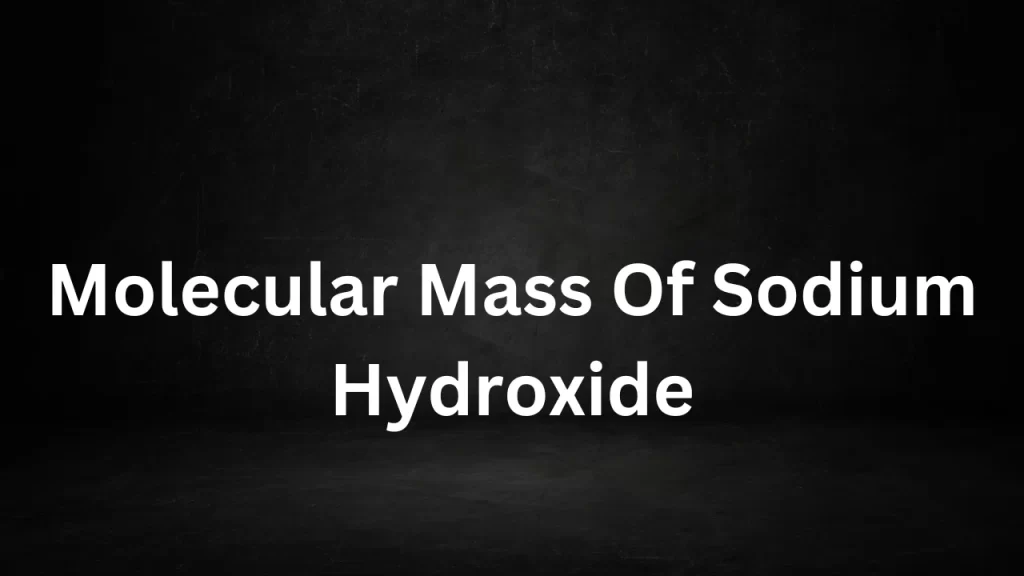Tag: caustic soda molecular weight
Molecular Mass Of Sodium Hydroxide
Molecular Mass Of Sodium Hydroxide: The mole mass of sodium hydroxide (NaOH) is a critical concept in chemistry, providing essential information about the composition and weight of this commonly used compound.
Sodium hydroxide, also known as caustic soda or lye, plays a pivotal role in various industrial processes, scientific experiments, and even household applications. In this article, we will explore what the molecular mass of sodium hydroxide is, how it is calculated, its significance in different fields, and its practical applications.

Molecular Mass Of Sodium Hydroxide
Understanding Molecular Mass
Molecular mass, also known as molar mass, refers to the mass of one mole of a specific substance, expressed in grams per mole (g/mol). In the case of sodium hydroxide (NaOH), its molecular mass represents the combined mass of one mole of sodium (Na) atoms, one mole of oxygen (O) atoms, and one mole of hydrogen (H) atoms.
Calculating the Molecular Mass
To calculate the mole mass of sodium hydroxide (NaOH), we add the atomic masses of its constituent elements:
- Sodium (Na): Atomic mass ≈ 22.99 g/mol
- Oxygen (O): Atomic mass ≈ 16.00 g/mol
- Hydrogen (H): Atomic mass ≈ 1.01 g/mol
Now, let’s calculate the mole mass of NaOH:
Molecular Mass of NaOH = (Molar Mass of Na) + (Molar Mass of O) + (Molar Mass of H) Molecular Mass of NaOH = (22.99 g/mol) + (16.00 g/mol) + (1.01 g/mol) Molecular Mass of NaOH ≈ 40.00 g/mol
Therefore, the mole mass of sodium hydroxide (NaOH) is approximately 40.00 grams per mole (g/mol).
Significance in Chemistry
- Stoichiometry: Sodium hydroxide’s molar mass is fundamental in stoichiometry, which involves calculating the quantities of reactants and products in chemical reactions involving NaOH. This plays a crucial role in various chemical industries.
- Analytical Chemistry: In laboratories, precise measurements of reagents and solutions, including sodium hydroxide, rely on its molar mass for accurate calculations and analytical procedures.
- Titration: Sodium hydroxide is often used as a strong base in titration experiments, where the molar mass is essential for determining the concentration of acids or other substances.
Practical Applications
- Chemical Manufacturing: Sodium hydroxide is a key ingredient in the production of various chemicals, including detergents, paper, textiles, and soap. Its molar mass is crucial in formulating these products.
- Water Treatment: In water treatment plants, NaOH is used for pH adjustment and water purification. Its molar mass is essential for precise dosing and chemical treatment.
- Soap and Cleaning Products: Sodium hydroxide is used in the production of soap and cleaning agents. Its molar mass influences product formulations and properties.
- Food Industry: It is employed for food preparation and processing, particularly in the production of foods like pretzels and hominy. Its molar mass is important for adherence to safety regulations.
Conclusion
The mole mass of sodium hydroxide (NaOH), approximately 40.00 g/mol, is a fundamental concept in chemistry with wide-reaching applications. It is indispensable in stoichiometry, analytical chemistry, and titration experiments, providing accurate measurements and calculations. Sodium hydroxide’s significance extends to various industries, including chemical manufacturing, water treatment, and the production of soap and cleaning products. Understanding the mole mass of sodium hydroxide is not only a foundational concept in chemistry but also a key factor in addressing practical challenges in diverse fields, from industrial processes to everyday applications.
Read More
- Molar Mass Of Ethyl Alcohol
- Molecular Mass Of Calcium Carbonate
- Molar Mass Of Carbon Dioxide
- Difference Between Force And Momentum
- Law Of Conservation Of Linear Momentum
- Molecular Weight Of MgSO4
- Molecular Weight Of H3PO4
Frequently Asked Questions (FAQs) On Molecular Mass Of Sodium Hydroxide
1. What is the molecular mass of sodium hydroxide (NaOH)?
The molecular mass of sodium hydroxide (NaOH) is approximately 40.00 grams per mole (g/mol).
2. How is the molecular mass of sodium hydroxide calculated?
To determine the molecular mass of NaOH, one adds together the atomic masses of its component elements: sodium (Na), oxygen (O), and hydrogen (H).
3. What is the atomic mass of sodium (Na)?
The atomic mass of sodium is approximately 22.99 g/mol.
4. What is the atomic mass of oxygen (O)?
The atomic mass of oxygen is approximately 16.00 g/mol.
5. What is the atomic mass of hydrogen (H)?
The atomic mass of hydrogen is approximately 1.01 g/mol.